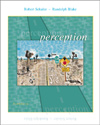| After studying the chapter, the student should be able to...
1.) Explain what is meant by structure from motion and more specifically, biological
motion. Discuss the importance of this form of perception. 2.) Explain optic flow and discuss how humans seem to use it to safely navigate
the environment. Discuss the relationship between optic flow and the difficulties
Alzheimer's patients demonstrate with motion perception. 3.) Distinguish between the two principle types of eye movement and discuss
the role of each type for the exploration of the visual environment. 4.) Define apparent motion, give an example of its affect and provide an explanation
as to how this sensation is produced. 5.) Explain what is meant by the correspondence problem in motion perception
and discuss how the visual system resolves this issue. 6.) Explain the aperture problem and discuss how the visual system copes with
this issue of ambiguity. 7.) Distinguish between the regions of the brain primarily devoted to motion
perception and discuss the neurological processes necessary for motion perception
to occur (i.e., direction-selective neurons). 8.) Explain what is meant by a motion aftereffect and the theory proposed for
this illusion. 9.) Explain how directional cues and certainty can influence motion perception. 10.) Discuss the influential effect of attention on motion perception. | 


 2002 McGraw-Hill Higher Education
2002 McGraw-Hill Higher Education